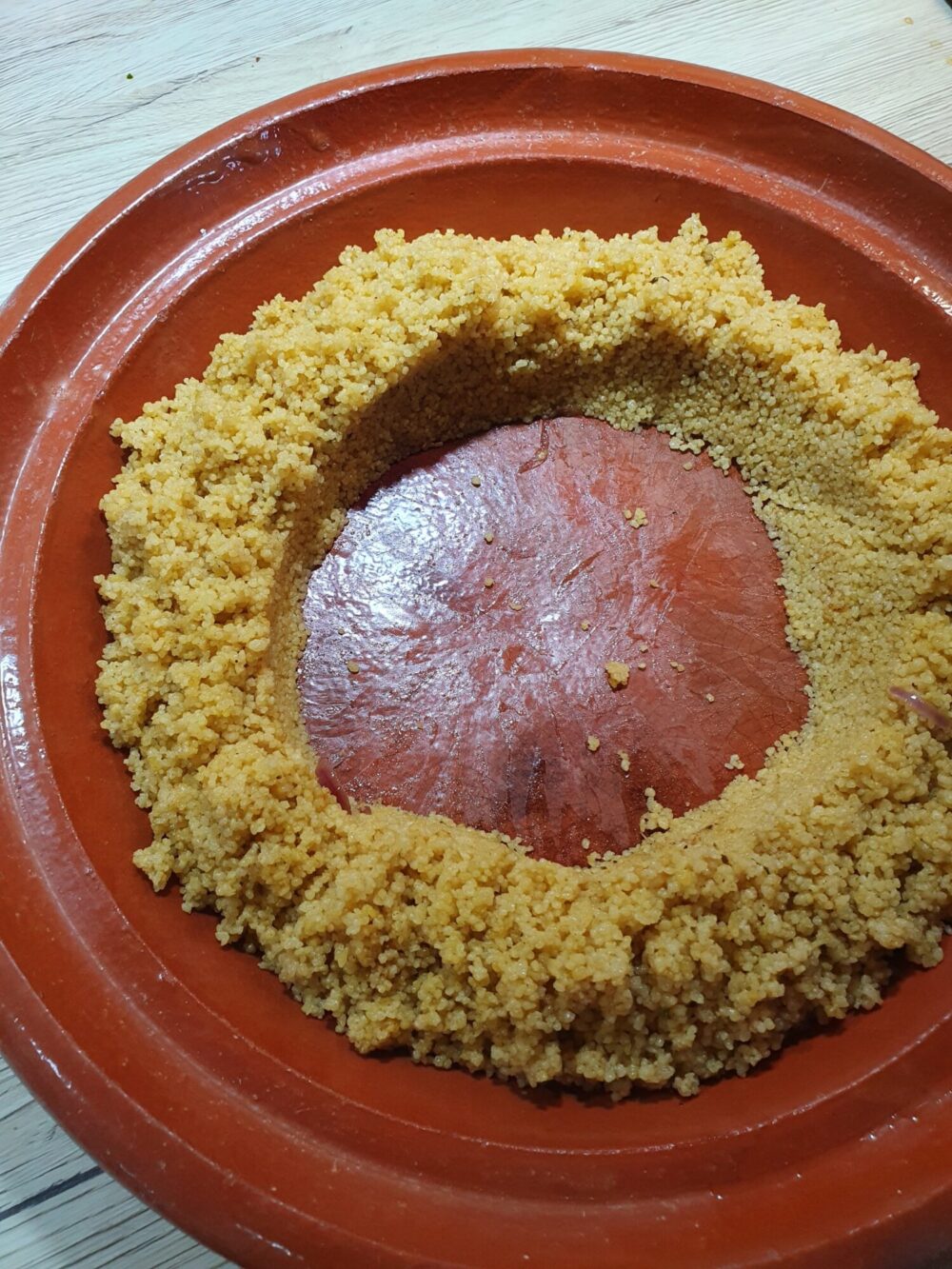Couscous is a North African staple consisting of steamed, crushed durum wheat semolina usually served with stewed meat, vegetables, or a mixture of both. In Morocco, where this chicken couscous is from, it is served at weddings, and special occasions, although most families gather around a large communal couscous dish every Friday.
Prepared best in a couscoussier, a traditional Moroccan food steamer made of two interlocking pots, it can still be done a much simpler way. The advantage of the couscoussier is that the first bottom pot holds the stew and broth used to produce the steam, and the second pot holds the couscous grains, so you can imagine the flavour!

In Morocco, serving couscous the right way is important. It is a festive dish and in essence the equivalent of the Sunday British roast or the Sunday family paella in Spain. Often served on a big beautifully glazed dish, the couscous is shaped into a mound and a well dug in the centre, where the meat and then the vegetables are placed all around. Then, you can either pour some of the incredibly rich broth over the couscous, meat, and vegetables, or serve that separately. I quite like my couscous dry. The chickpeas are usually distributed around with a large amount of Tfaya over the top.
For this recipe, I used two poussins, but a whole chicken or separate parts can be used. You will need olive oil, an onion, two garlic cloves, salt and black pepper, 1 tsp turmeric powder, 1 tsp ground ginger, 1 tsp cumin, tomatoes, carrots, pumpkin, turnip, cabbage, canned chickpeas, dry couscous and unsalted butter. For the tfaya, 2 large yellow onions, olive oil, salt, 1/2 tsp turmeric powder, 1/2 tsp ground ginger, 1 tsp cinnamon, 1/4 cup raisins, I quite like golden ones, and 1 tbsp sugar.

If you are using a couscoussier you add some olive oil, and fry the chopped onion, garlic, and seasonings. Stir and sauté until the onions soften and then brown the chicken, flipping it as you go. You then add 1 cup water, cover, and cook for about 30 min if it’s a whole chicken. At that point you would add the cabbage and carrots 1/2 cup of water, and cover. You then grease the top part of the couscoussier, the actual steamer, and in a bowl, combine dry couscous grains with 1 tsp salt, 2 tbsp olive oil, and mix with your hands until it’s all combined. To that, you add 1 cup of room temperature water and let the couscous absorb it for 10-15 minutes without mixing it. Once 15 minutes are over you would add the softer vegetables to the broth, and then cover with the steamer part to finish cooking off the couscous. This usually takes another 15 minutes. Of course, you can prepare it the easy way following package instructions.
Once it’s done you put the couscous back into the large bowl, add unsalted butter and salt to taste, and fluff with the hands. In Morocco, they use a fermented butter called smen, which is not everybody’s cup of tea given it has a pungent smell. If couscous is too hot, you may use a wooden spoon to fluff it, but again Moroccans have steal fingers. Your couscous should be tender and fluffy by now!

For the tfaya, you sauté onions in olive oil with salt, turmeric powder, and ground ginger on medium-low for 20-25 minutes, stirring occasionally. You then add raisins, ground cinnamon, and granulated sugar and cook until it takes on a soft honey-like texture, usually 30 minutes. If the sauce gets too thick, though, some broth will help and I like to add a little honey.
Even though many people today use a spoon or fork to eat couscous, it is traditionally eaten with their hands. The right hand can only be used for eating in Morocco and when diners gather couscous between their fingertips, they roll it, press it into a ball, and eat it. I have to stick to using cutlery!
Text And Photography By Mark Montovio




